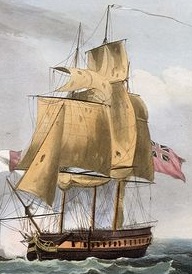HMS Shannon (1757) facts for kids

Shannon was built to the same design as HMS Carysfort, (pictured)
|
|
Quick facts for kids History |
|
|---|---|
| Name | HMS Shannon |
| Ordered | 18 April 1757 |
| Builder | Deptford Dockyard |
| Laid down | 11 May 1757 |
| Launched | 17 August 1757 |
| Completed | 8 October 1757 |
| Commissioned | August 1757 |
| Fate | Taken to pieces at Portsmouth December 1765 |
| General characteristics | |
| Class and type | 28-gun Coventry-class sixth-rate frigate |
| Tons burthen | 587 53⁄94 bm |
| Length |
|
| Beam | 33 ft 8 in (10.3 m) |
| Depth of hold | 10 ft 6 in (3.20 m) |
| Sail plan | Full-rigged ship |
| Complement | 200 officers and men |
| Armament |
|
HMS Shannon was a 28-gun Coventry-class sixth-rate frigate of the Royal Navy. This means it was a medium-sized warship with 28 cannons, used by Britain's navy in the 1700s.
Contents
Building the Shannon
Why Fir Wood?
The Shannon was special because it was built using fir wood instead of the usual oak. Fir was cheaper and easier to find than oak. It also allowed the ship to be built much faster. However, there was a downside: fir wood didn't last as long as oak. Most fir-built ships like the Shannon only lasted about nine years before they were too old to use.
Naming the Ship
The ship was named after the River Shannon in Ireland. The British Admiralty, which was in charge of the Royal Navy, often named ships after places. This tradition started way back in 1644. Many ships in the Coventry-class were named after famous regions, rivers, or towns. Other ships in this class were named after figures from classical antiquity, like ancient Greek or Roman heroes.
Ship Design and Features
The Shannon's design was similar to French frigates of its time. However, it had a shorter, stronger hull and carried heavier guns. It was also wide, which meant there was plenty of space for food and supplies. It had a large magazine to store powder and cannonballs.
These features allowed the Shannon to stay at sea for a long time without needing to resupply. It also had strong, wide masts. This helped balance the ship and made it more stable in rough seas. It could also carry more sails, which helped it move faster in good winds. The only real downsides were that it was a bit slower in light winds and not as easy to turn quickly.
Who Was on Board?
The Shannon usually had a crew of 200 people. This included two main officers: a captain and a lieutenant. Below them were 40 warrant and petty officers, who were experienced sailors. There were also 91 regular sailors, 38 Marines (soldiers who served on ships), and 29 other crew members, including servants.

